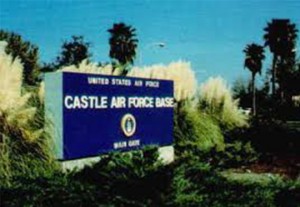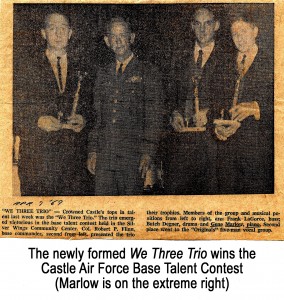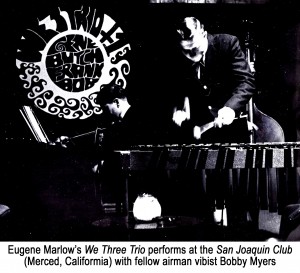It is a truism that those you encounter early in one’s career or artistic development who put you on the right path can be important influencers in the short and long-term. Four such people in my early evolution as a musician in the mid-late 1960s are bassist Frank LaGorce and drummer Butch Degener, and later bassist Sonny Jay and drummer Rudy Merino.
Even though I was born into a family with strong classical music roots on both my mother and father’s side, I did not begin to take music study seriously until I was in my early twenties. For me the context was the military, more specifically, I enlisted in the United States Air Force on June 20, 1966 in response to a draft notice from the United States Army earlier in the year. Little did I know that this decision would result in the awakening of semi-dormant musical genes.
Following basic training at Lackland Air Force Base (San Antonio, Texas) in the summer of 1966—where my then meager pianistic skills were put  to work playing in a dance band for a retiring general—and a short stint at Chanute Air Force base in Illinois (now closed), where I received some training in B-52 and KC-135 tanker aircraft personal equipment, I ended up at Castle Air Force Base (AFB) (closed in 1996) in Merced, California, right in the middle of the San Joaquin Valley. This was ultimately an interesting assignment. Castle AFB at the time was the training base for all of Strategic Air Command, one of the key military elements of the War in Vietnam.
to work playing in a dance band for a retiring general—and a short stint at Chanute Air Force base in Illinois (now closed), where I received some training in B-52 and KC-135 tanker aircraft personal equipment, I ended up at Castle Air Force Base (AFB) (closed in 1996) in Merced, California, right in the middle of the San Joaquin Valley. This was ultimately an interesting assignment. Castle AFB at the time was the training base for all of Strategic Air Command, one of the key military elements of the War in Vietnam.
When I arrived in fall 1966 Merced was a town of 16,000 people (not counting military personnel). When I left in fall 1971 (after almost completing an MBA in General Management from Golden Gate University) the population was closer to 25,000. As of 2014 its population was slightly under 82,000, consisting of mostly Mexicans and several South-Asian cultures.
Almost immediately upon unpacking my duffle bag, I made my way to the base Silver Wings Community Center where I discovered two fairly soundproof piano rooms each hosting a spinet piano. While playing through the nine or ten jazz standards I knew at the time, there was a knock on the door. It was Frank LaGorce, a staff sergeant assigned to one of Castle AFB’s mechanical squadrons who also played jazz bass. He was a “cat” in the jazz sense. Much of his conversation was sprinkled with “jive talk.” How he survived in the military is still a mystery to me, but he played an upright base and (at the time) knew more than I did about chords and changes. And we got along.
We put together a trio with an ex-rock drummer—Butch Degener. Teaching him how to play ballads with brushes—as opposed to sticks—was a challenge. But he ultimately got the idea. I began to play around with some arrangements, including “Sunrise, Sunset” from the Broadway Show “Fiddler on the Roof.” We entered the December 1966 base talent show and, “Miracle of Miracles,” won first place. A few weeks later we landed an off-base gig at the local San Joaquin Club in Merced  playing there Friday and Saturday nights, four hours a night, 9 p.m.-1 a.m., for $25 a night. We were there for over a year continuous.
playing there Friday and Saturday nights, four hours a night, 9 p.m.-1 a.m., for $25 a night. We were there for over a year continuous.
We survived in the early going by playing all 10 of the tunes I knew several different ways: ballad, bossa nova, swing, rock, whatever worked. Almost immediately upon getting the gig I visited the local music store on Merced’s main street and bought a set of Hanon exercises—books I still have. I started practicing at least two-three hours every night after my regular military duties (which is another story) and even more hours on weekends. I worked on expanding my repertoire. At one point I knew over 100 tunes without need of a lead sheet (not much by some standards; there are some pianists who know a 1,000 tunes off the top of their heads). Tony Bennett’s “I Left My Heart in San Francisco” was a sure-fire tune to bring everyone to the dance floor. Just playing the first few notes was like magic.
 For a time the trio expanded to a quartet with the addition of Bobby Meyers—a vibraphonist, also an airman at the base—and we became “The We Trio +1.” Ultimately, though, as my pianistic skill improved and my chordal knowledge and repertoire expanded I felt a strong urge to seek greener musical pastures. Before Frank’s fateful knock on the piano room door I had not taken piano study or any music study for that matter very seriously. I had composed perhaps a few dozen jazz pieces, but didn’t have the chops to write them down. In many, many ways, I was musically clueless as a performer. Yet my serendipitous encounter with Frank LaGorce put me on a path that I still walk on to this day. But sometimes there comes a time when you need to cut ties with first teachers.
For a time the trio expanded to a quartet with the addition of Bobby Meyers—a vibraphonist, also an airman at the base—and we became “The We Trio +1.” Ultimately, though, as my pianistic skill improved and my chordal knowledge and repertoire expanded I felt a strong urge to seek greener musical pastures. Before Frank’s fateful knock on the piano room door I had not taken piano study or any music study for that matter very seriously. I had composed perhaps a few dozen jazz pieces, but didn’t have the chops to write them down. In many, many ways, I was musically clueless as a performer. Yet my serendipitous encounter with Frank LaGorce put me on a path that I still walk on to this day. But sometimes there comes a time when you need to cut ties with first teachers.
This is where bassist Sonny Jay and drummer Rudy Merino came into the picture.
More in my next blog.
Eugene Marlow, Ph.D.
July 20, 2015
© Eugene Marlow 2015


